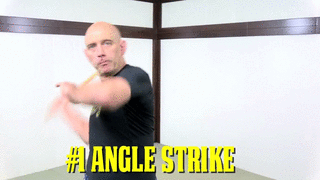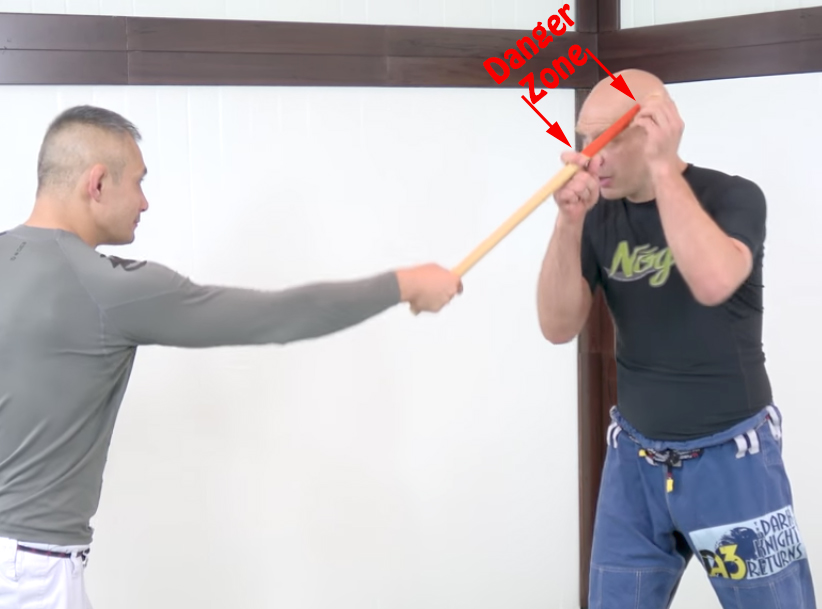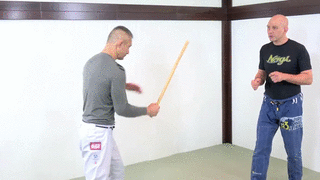Let’s talk about self defense against a stick attack.
And keep in mind that this information also applies to bats, saps, batons, clubs, tactical flashlights, or pieces of 2×4 lumber. We’re just using the word ‘stick’ as shorthand, because the principles and techniques are the same for dealing with all blunt weapons.
First I’ll give you the information in video form (this was fun to film) and then we’ll summarise it in written form and pictures below.
Here’s the video I shot and put onto Youtube called Defending Against a Stick; the Highest Percentage Techniques
So let’s quickly summarise the information in the video above.
It’s really important to understand that most stick and blunt object attacks will follow the same trajectory. Which brings us to the next topic…
The Most Common Stick Attack
If you study the Filipino martial arts you’ll learn many different weapon techniques, and a ton of different angles to strike your opponent.
But it’s important to realise that there is ONE strike that gets used more than any other.
In most systems it’s called the ‘Number One’ and if you’re wielding a stick in your right hand then it’ll hit down towards your opponent at roughly a 45 degree angle (give or take) from your upper right quadrant.

This is the angle that gets used the most by completely untrained people, by riot police, and by experienced full contact stick fighters like the Dog Brothers.
It’s the angle that people revert to in a real situation after the tsunami of adrenaline has washed away all fine motor control and trained responses.
So we absolutely, positively have to have an answer to this strike.
The Most Dangerous Part of the Stick
Here’s something that’s pretty obvious once it’s pointed out, but a lot of people don’t know it…
It’s the end of the stick that’s the really dangerous part!
If you hit me with a stick and you clip me with the final 1/3rd of it then you’re going to do real damage. This is the part of the stick that breaks bones, splits skulls, and can knock you out or kill you.

If you hit me with the middle portion of the stick, or the part closest to your hand, then yes, it’ll still hurt, but the damage will be a lot less.
Of course it’s also totally possible to hit someone with the butt of the stick too (known as the ‘punyo‘ in many Filipino martial arts), but that requires a higher level of training and is less common in the street.
Defending Against the Stick
A stick is a potentially deadly weapon, and in any empty-hand vs weapon scenario you should always use the Reebok defense (i.e. run like hell).
And if you can’t run, or don’t think that you’ll be able to run faster than your opponent, then you should arm yourself. Pick something up because having almost anything in your hand is better than having nothing (for example, in 2017 a South Caroline man actually used a plastic lightsaber to defend himself against a knife attack).
Use that object to block, parry, absorb the hit. Worst comes to worst, you can throw it to distract the guy and then run.
But let’s say that you can’t run and there’s nothing to pick up. What do you do?
The trick is to stay right outside the danger zone so that he can’t hit you, OR to be inside the danger zone and clinch him.
Crossing the danger zone requires good timing and total commitment.
Wait until he retracts to hit you or right after he has swung and missed. Then you have to close at full speed and accept that you might get hit in the process. Don’t go slow, and don’t stop if you get hit.
It’s like Yoda said, “Do or do not. There is no try!”

To train this I suggest that you put on a fencing helmet to protect your head, hockey gloves to protect your fingers, and give a training partner a hard rattan stick. Tell him that his job is to hit you, and all you’re going to do is clinch with him.
If you do that exercise with someone really trying to hit you then I promise you’ll learn more about self defense in 10 minutes than in 10 hours of practising techniques on a compliant partner.
(You’ll also get some wicked bruises on your arms and body, but that can be kind of a cool conversation starter around the water cooler the next day.)
I could talk more about the timing of crossing the danger zone, but I think the best format for that is video so you can actually see what’s going on. If you want more information this topic then check out the video at the top of this post (or click here to watch Defending Against a Stick on the Self Defense Tutorials channel on Youtube).
And if you found this article useful then consider signing up for our free Self Defense Tips email newsletter.
We put out some of our best tips, tricks and techniques via email, and if you don’t like what you get then you unsubscribe easily at any time by following the link at the bottom of every email we send out. Click here to sign up.
Take care, and I hope you NEVER need to use this information.
Stephan Kesting